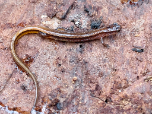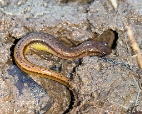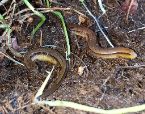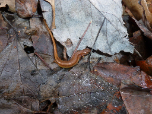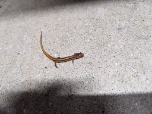Chamberlain's Dwarf Salamander (Eurycea chamberlaini)
Description: Chamberlain's dwarf salamander is a newly described species that was recently recognized as distinct from the more common, dwarf salamander (Eurycea quadridigittata). Chamberlain’s dwarf salamander is lighter in color than the more common form, having a yellow underside that lacks any markings. Chamberlain's dwarf salamander is a very small salamander averaging approximately 0.9 inches in total length.
Habitat: This species occurs in a variety of habitats but seems to prefer vegetated seepage areas near streams or ponds, particularly in forested areas of the piedmont and upper coastal plain regions.
Range: The geographic range of this species was previously incompletely known. Harrison and Guttman (2003) stated that it was known from portions of the piedmont in both North and South Carolina, the upper coastal plain in South Carolina, and portions of the central coastal plain in North Carolina. Wray et al. (2017) re-delineated this species following their analysis of the Eurycea quadridigitata group, limiting it to North Carolina and South Carolina, but noting that further work in northeastern Georgia may detect the species.
Found in these States:
GA |
NC |
SC
Diet: Unknown, but this is a species with a highly projectile (boletoid) tongue, and is therefore likely to be a sit-and-wait predator. Prey items eaten by adults are probably similar to those consumed by dwarf salamanders; these include earthworms, several kinds of insects, spiders, pseudoscorpions, mites, ticks, and millipedes.
Reproduction: Eggs are reported to be scattered about singly or in groups of 3–6 among dead and decaying leaves in seepages and runs from springs. Clutch size is unknown. However, Harrison and Guttman (2003) report that the mean number of large, yolk-laden ovarian eggs in Chamberlain’s dwarf salamanders is 45.2 (35–64). Most or all of these probably are oviposited. Most hatching occurs in March with metamorphosis occurring 2–3 mo later.
Status: Listed as Least Concern in view of its wide distribution, presumed large population, and because it is unlikely to be declining fast enough to qualify for listing in a more threatened category.
Taxonomy: It was previously thought to be a color morph of the Coastal Plain dwarf salamander (Eurycea quadridigitata), but was described in 2003 as a distinct species based on distinct morphology and behavior. A 2017 study reaffirmed it as being a distinct species.
»» Kingdom: Animalia - Animals
»» Phylum: Chordata - Chordates
»» Subphylum: Vertebrata - Vertebrates
»» Class: Amphibia - (Amphibians)
»» Order: Caudata - Salamanders
»» Family: Plethodontidae - Lungless Salamanders
»» Genus: Eurycea
»» Species: Eurycea chamberlaini - Chamberlain's Dwarf Salamander
This article uses material from the Wikipedia article "Chamberlain's Dwarf Salamander", which is released under the Creative Commons Attribution-Share-Alike License 3.0. Content may have been omitted from the original, but no content has been changed or extended.
|



